| Pages:
1
2
3 |
DraconicAcid
International Hazard
    
Posts: 4278
Registered: 1-2-2013
Location: The tiniest college campus ever....
Member Is Offline
Mood: Semi-victorious.
|
|
Have you checked the pH of that solution?
Anyway, I found a table that gives reduction potentials for some organic things:
Dehydroascorbic acid + 2 H+ + 2e -> ascorbic acid E = + 0.390 V.
This tells me that the overall potential for AA + Cu(2+) --> DHA + 2 H(+) + Cu(s) is -0.053 V, so thermodynamically unfavourable under standard
conditions. If you reduce the concentration of hydrogen ions, that will make the reaction more favourable, and it will be spontaneous at a pH of 2 or
greater.
The table doesn't have any sugars on it, but it does have HCO2H + 2H(+) + 2e --> H2CO + H2O E = +0.056 V, so if we declare that all aldehydes will
be basically the same, we can say that:
RCHO + H2O + Cu(2+) --> RCO2H + Cu(s) + 2 H(+) will have E = 0.28 V and thus be spontaneous (and the lower the concentration of H+, the more
spontaneous it should be).
(As an aside, I did once heat copper sulphate in a concentrated solution of sugar, thinking the higher viscosity might favour larger crystals. It
gave copper powder.)
If you have chloride in solution, you should have no trouble getting CuCl forming instead of copper metal.
ETA: I dissolved 0.15 g CuO in 2 mL of 6 M HCl, added 1 mL of 1 M NaOH and 0.7 g of glucose in distilled water, and have been heating in a hot water
bath. I will report any changes.
ETA: Nothing happened for a while, so I added 1.6 g sodium chloride and adjusted the pH to about 6 with acetic acid and sodium hydroxide- lots of
greenish precipitate.
ETA: Said precipitate dissolves readily in dilute HCl, and therefore must have been either the hydroxide, or basic chloride. I'll try again tomorrow,
adjusting the pH to keep the copper in solution first, then adding glucose.
[Edited on 20-12-2017 by DraconicAcid]
Please remember: "Filtrate" is not a verb.
Write up your lab reports the way your instructor wants them, not the way your ex-instructor wants them.
|
|
|
semiconductive
Hazard to Others
  
Posts: 287
Registered: 12-2-2017
Location: Scappoose Oregon, USA.
Member Is Offline
Mood: Explorative
|
|
I broke the seal on the flask, and took a sample of about 1CC, and used about 1/10th a soil pH test pill meant for 10 CC of water. The solution
color changed to slight purple, which is not an indicator color ... but since the color was blue-green to begin with, the color of the pH indicator
can not be adding green but must be adding tan/orange/red to the solution.
see photo:
From top of the color chart to bottom pH is: 7.5, 7.0, 6.5, 6.0, 5.5, 5.0, 4.5 (or below).
The pill powder is white. Looking at the powder near the bottom of the container shows a tan discoloration, not quite orange. That puts the pH at
about 5.5 to 6.
Edit: ( I diss a suppress blue channel in top of the liquid, to give a better idea of color since blue is not part of pH scale. I would estimate a
pH of 6 to 6.5 with modified color. )
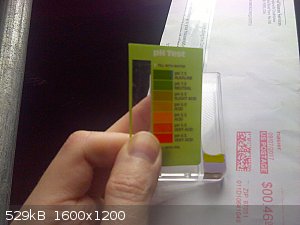
At my house, when reverse osmosis or distilled water is exposed to air for 24 hours I get about a pH of around 5.5. The pH of the copper solution is
pretty much in the same range, so I assume that actual solution is either neutral or slightly acidic depending on how much CO2 is dissolved in the
water.
Copper sulfate precipitated with sodium carbonate normally doesn't form pure carbonate, but from what I'm told it forms copper hydroxide carbonate.
OH-Cu-CO3-Cu-OH.
But, I don't see any reason that copper couldn't also form longer chains with carbonate...
eg: something like: OH-Cu-CO3-Cu-CO3-Cu-OH
The longer the chain, the higher the density of the molecule; and the more likely it would be to settle to the bottom of the flask or precipitate.
Hydrogen ions, whether they are from HCl or from carbonic acid will act the same in solution regardless of where they came from; but for various
salts and acids, there are different solubility and ionization products determining dynamic equilibrium.
Eg: some acids, like sulfuric, have an ionization constant that is very high for the first proton (hydrogen atom) removed. But a much smaller
ionization product (if I recall correctly) for the second proton. So, sulphuric acid would have 100% 1st ionization, but not quite 100% second
ionization. H-Cl is pretty much 100% ionized all the time. That's the nature of strong acids.
However, carbonic acid is a weak acid and shouldn't we treat it differently / theoretically?
Why is is that copper forms basic copper carbonate, rather than pure copper cabonate?
Would it form pure copper carbonate in solution if I added pressuized CO2 to the liquid?
( Calcium carbonate, for example, can be dissolved in carbonic acid ).
eg: Isn't it likely that some acids are less likely to be ionized by water and separated from the copper atoms than others?
In the experiment I did, is it possible that the hydroxides of basic copper carbonate have been neutralized into water from the hydrogen supplied by
HCl, but the remaining carbonates are not disassociated from the copper at all?
Is there such a thing as copper (I) carbonate? Cu-CO3-Cu
Or is copper always ionized in water to +2, so that H+ OH- so that the solution is:
+Cu-CO3-Cu+
What's the difference between adding HCl, to remove the OH radiacls by supplying free H+ ions, and supplying an electron to reduce copper to the +1
oxidation state?
How do we know which ion species are soluble in water, and which aren't?
eg: the hydroxide carbonate (OH-Cu-CO3-Cu-OH) is not soluble; But,, does that mean that when I add enough HCl to make: Cl-Cu-CO3-Cu-Cl (on drying);
that this chloride half salt is insoluble? ( I am assuming hydroxide is more easily displaced than carbonate. )
Edit: The pH indicator powder color is getting closer to orange with time, so that means the solution exposed to air is becoming slightly more acidic
with time.
(Picture after several hours, I electronically removed the offending color blue .. since the chart is purely red-green, should make it easier to tell
ph. eg: Between 5.5 and 6. )
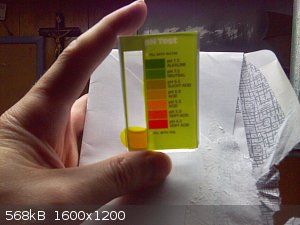
[Edited on 22-12-2017 by semiconductive]
|
|
|
DraconicAcid
International Hazard
    
Posts: 4278
Registered: 1-2-2013
Location: The tiniest college campus ever....
Member Is Offline
Mood: Semi-victorious.
|
|
Quote: Originally posted by semiconductive  |
Copper sulfate precipitated with sodium carbonate normally doesn't form pure carbonate, but from what I'm told it forms copper hydroxide carbonate.
OH-Cu-CO3-Cu-OH.
But, I don't see any reason that copper couldn't also form longer chains with carbonate...
eg: something like: OH-Cu-CO3-Cu-CO3-Cu-OH
The longer the chain, the higher the density of the molecule; and the more likely it would be to settle to the bottom of the flask or precipitate.
|
This is an ionic compound, not a polymer, and not a molecule. You have a regular arrangement of copper ions, carbonate ions, and hydroxide ions that
repeats over and over and over again. The unit cell looks like this:

Now imagine that as a brick, and you've got a vast number of these bricks stacked together into a block that's billions of blocks long, billions of
blocks wide, and billions of blocks high. That's a very tiny crystal of basic copper(II) carbonate. The bigger the crystal, the better it will
settle, but that has more to do with mass and solution viscosity than density.
| Quote: | Hydrogen ions, whether they are from HCl or from carbonic acid will act the same in solution regardless of where they came from; but for various
salts and acids, there are different solubility and ionization products determining dynamic equilibrium.
Eg: some acids, like sulfuric, have an ionization constant that is very high for the first proton (hydrogen atom) removed. But a much smaller
ionization product (if I recall correctly) for the second proton. So, sulphuric acid would have 100% 1st ionization, but not quite 100% second
ionization. H-Cl is pretty much 100% ionized all the time. That's the nature of strong acids. |
That is correct.
| Quote: | However, carbonic acid is a weak acid and shouldn't we treat it differently / theoretically?
Why is is that copper forms basic copper carbonate, rather than pure copper carbonate?
Would it form pure copper carbonate in solution if I added pressuized CO2 to the liquid?
( Calcium carbonate, for example, can be dissolved in carbonic acid ).
eg: Isn't it likely that some acids are less likely to be ionized by water and separated from the copper atoms than others? |
I'm not actually sure why copper forms a basic carbonate rather than a simple one; it also tends to form a basic chloride and a basic sulphate rather
than a simple precipitate of the hydroxide. I've read that you can crystallize a non-basic copper(II) carbonate from a saturated solution of sodium
carbonate, but I've never tried it.
There are some anions which will coordinate to copper ion solution, particularly if the anion is concentrated. You can make ions such as CuCl4(2-).
Carbonate is a lousy ligand, but will coordinate to copper in an extremely concentrated solution.
| Quote: | | In the experiment I did, is it possible that the hydroxides of basic copper carbonate have been neutralized into water from the hydrogen supplied by
HCl, but the remaining carbonates are not disassociated from the copper at all? |
No- as I said, carbonate is a lousy ligand.
Please remember: "Filtrate" is not a verb.
Write up your lab reports the way your instructor wants them, not the way your ex-instructor wants them.
|
|
|
semiconductive
Hazard to Others
  
Posts: 287
Registered: 12-2-2017
Location: Scappoose Oregon, USA.
Member Is Offline
Mood: Explorative
|
|
I'm preparing to repeat the experiment. My intention is to use ascorbic acid as reducing sugar, and carefully test the dissolution of basic copper
carbonate in HCl to insure I don't have excess HCl.
I think I made a math mistake in the first post, though it doesn't change the conclusions.
The number of moles I computed was slightly off.
I'd appreciate someone double checking my molecular weights and formula.
I think the following is the reaction to produce basic copper carbonate:
2CuSO4 + 1H2O + 2Na2CO3 --> 2Na2SO4 + Cu2CO3[OH]2 + CO2
This time I weighed 2.508g of CuSO4 * 5H2O @ 249.685g/mol --> 0.01004 mol
I added Na2CO3, (Washing soda, not bicarb) until the water went almost perfectly clear,
A large amount of bubbles were formed, so it's not a simple metastasis reaction; but hydroxide is being absorbed from the water and gasses are being
released (CO2)
I added filter paper to a Buchner funnel, weighing 0.218mg. I was hoping to be able to weigh the filter paper and get a more accurate total
conversion mass. (To track losses of chemical). Then I vacuum filtered the solution with a single rinse of 50ml water. I won't do this again in
the future as getting all the carbonate out was difficult.
I tried heating the Buchner funnel and paper afterward to dry the carbonate, but I used too much heat and some black oxide formed in the carbonate,
making it impure; so I'll have to re-do the experiment tomorrow to get a precision measurement.
Basic copper carbonate is supposed to have a mass of 221.113g/mol ; and two moles of copper sulfate, should produce one mole of basic copper
carbonate. (Therefore, 0.01004mol --> 0.00502 mol) I should have a maximum of 1.1105 grams of precipitate. However, I got almost 1.4grams after
subtracting the filter paper weight, which is way to high ( 0.0057 mol. ) The filtrate wasn't perfectly dry, so it could also be moisture.
In any event, I was mostly interested in how much acid it would take to dissolve all the copper carbonate (0.005 moles worth.), so I weighed out 1.904
grams of HCL solution at 31.45% concentration which should be ~~0.599g HCl @ 36.461g/mol, --> 0.0164 moles. That's the same amount I used last
time, and can neutralilze the hydroxide (but not all the carbonate) of 0.0082 moles of basic copper carbonate. (eg: 0.05 moles of basic copper
carbonate). The amount of HCl used, I think, was a mistake in the first post of this thread.
However, this time when I added the acid ... I did it without rapid stirring. I wanted to see exactly when all the precipitate was dissolved, so I
could weigh the remaining acid. I also wanted to see how much gas (if any) would be released which is hard to see when stirring vigourously. If
the acid was only neutralizing hydroxides, there would be no bubbles ... but if it was displacing the CO2, then there would be bubbles.
I added diluted HCl drop by drop (I added water to make 15g total from the 1.9g I measured ). There was a very small amount of bubbling as I added
diluted acid, but no where near the volume of CO2 released when making the basic CuCO3[OH2] from washing soda. I noticed that the black oxide
dissolved first, and the carbonate dissolved last. I expected to stop adding acid when all the carbonate dissolved, but even with all the HCl added,
there is still a small amount of carbonate left on the bottom of the flask.
That's when I realized that copper oxide takes more acid to dissolve than does carbonate. CuO --> CuCl2. Since some carbonate was escaping due
to not stirring, I was producing more CuCl2 than the last time I did the experiment.
So, I'll try again tomorrow and have someone double check all my measurements and steps. How quickly acid is added, and the amount of copper oxide
present, and stirring rate obviously affects the amount of carbonate that stays in solution.
Note: The HCl is sold as 31.45% solution, but half has been used up and since a little gas fumes out each time I open up the cap ... it's likely
lost some HCl strength.
Edit: Adding pictures; Although the quantites and sources of reagents started with (1 gallon muriatic acid jug, root killer CuSO4.5H2O) are the
same; the processing was different. The primary differences are that the original experiment added chloride to carbonate at room temperature (21.5C)
under vigorous stirring; while the second experiment did it at 55C with little to no stirring at first. The carbonate of the second experiment was
also accidentally burnt, which caused some of the carbonate to turn in to copper II oxide. (black.) Sugar will not be added to the second experiment,
because it's already defective.
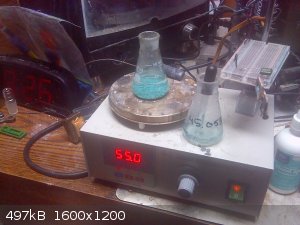 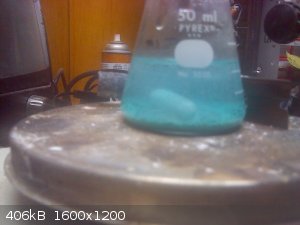
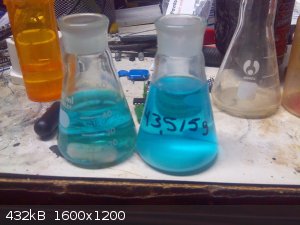 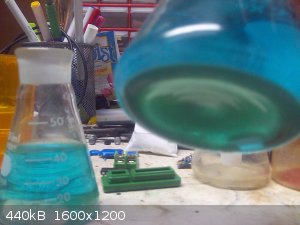
Note: In the first picture, the tare weighted flask is just holding diluted HCl while the stove flask is the second experiment (Tare weight is on back
side of flask); but the truly un-marked flask is only on the left in the final two pictures. The unmarked left flask is the original experiment,
uncapped, to allow air in at room temp.
The final two pictures are after allowing both experiments to sit over-night in open air: No extra precipitate formed in the original experiment due
to air; and the remaining precipitate in the second experiment did not dissolve due to air. Note the color of the precipitate in the right flask
looks different when viewed from above (though solution) or below (through glass).
[Edited on 22-12-2017 by semiconductive]
|
|
|
semiconductive
Hazard to Others
  
Posts: 287
Registered: 12-2-2017
Location: Scappoose Oregon, USA.
Member Is Offline
Mood: Explorative
|
|
Quote: Originally posted by DraconicAcid  |
This is an ionic compound, not a polymer, and not a molecule. You have a regular arrangement of copper ions, carbonate ions, and hydroxide ions that
repeats over and over and over again. The unit cell looks like this:

|
I'm looking at it ... but that diagram does not match the molecular formula I have been told represents basic copper carbonate. It also depicts bonds
that defy normal oxidation states.
The black atom has to be carbon, and the red ones are oxygen. Therefore, the lighter orange ones are copper and the grey/white are hydrogen.
The molecular formula I learned for basic copper carbonate is: HO-Cu-CO3-Cu-OH
The carbonate CO3, has one double bonded oxygen, and two single bonded oxygens.
Cu-OH
|
O
|
C=O
|
O
|
Cu-OH
Empirical:
1C:2H:5O:2Cu
But, instead of having one copper atom attached to the carbonate on each side, the drawing has two copper atoms. It doesn't make sense to me.
Three bonds puts oxygen in the -3 state .... !?
It's cool looking, but I have no idea what kind of bonds it's trying to depict. Oxygen doesn't make three single bonds.
I can see the way it's supposed to repeat in 3D; and counting the atoms that have bonds:
4C : 8H : 20O : 8Cu Since everything's a multiple of 4, that's 1C : 2H : 5O : 2Cu
The stoiciometry is correct ... however, it's impossible to understand why some of the oxygens have three bonds to carbon/copper or single bonds to
hydrogen.
Hydrogen monoxide ?
[Edited on 22-12-2017 by semiconductive]
|
|
|
semiconductive
Hazard to Others
  
Posts: 287
Registered: 12-2-2017
Location: Scappoose Oregon, USA.
Member Is Offline
Mood: Explorative
|
|
Quote: Originally posted by zed  | Ummm. I'm not very careful, but when I mix CuSO4 solution and Ascorbic Acid, and return a week or so later, I find nano particles of copper, and a
clear solution. That's it. Now, if there is Cu 1+ remaining in the solution, I haven't checked.
Got experimental details, from some folks that claim to have the Cu1+ thing..... pretty well wired.
https://www.dimanregional.org/site/handlers/filedownload.ash... |
Thanks for the link. I reproduced the lab experiment, at 1/12.5 mass and volume reduction. I got the results predicted by the link. I even used
impure/iodized table salt (600mg) and 99+% root killer CuSO4.5H2O (800mg) with ascorbic acid (600mg). Instead of 50mL/solution I used 4mL. I shook
the CuSO4 + NaCl solution, but did not shake the combined mixture of ascorbic acid in water + the salt solution in water. The combining of two
solutions was done at room temperature 21.5C. I simply transferred ascorbic solution using an eye dropper into the copper solution. I saw it begin
to turn colloidal immediately with the blue solution sinking to the bottom and turning green; so I photoed mid reaction; and then after transferring
all the ascorbic acid, I capped the vial and left it for 10 minutes. There are three layers at the end (leftmost shot) in the vial; The expected white
precipitate is on bottom. an unexpected dark green aqueous layer is on top of that; and then clear solution to the top of the vial.
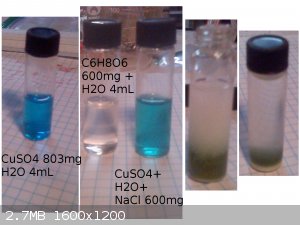
The stoichiometry as shown in the paper is probably off a little bit, as the green layer does not precipitate even after a long time. But I
replicated the ratio of chemicals in the lab paper, rather than work it out theoretically. ( EDIT: ideas were written after one hour ... see photo
below for 16 hours later. Crystalization (not precipitation) can be seen on the glass of the vial in the region where the green layer still is. The
color hasn't really changed, but it's much more transparent. The diffusion of liquids is amazingly slow in this reaction. The green band is mostly
still visible at the bottom of the vial, with only a tiny amount of green color in the nearly clear fluid above it.)
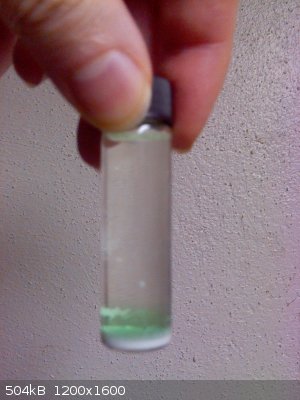
You can see the color change from pure blue (leftmost picture SO4) to aqua-marine (2nd to left SO4 + Cl) because of the addition of table salt to the
solution. So the color change mentioned in the lab worksheet is obvious (in spite of my blue-biased camera.); But both vials are still copper II
ionization state.
I've repeated the same experiment using glucose, which is a reducing sugar with more hydrogen but the same oxygen's and carbons as ascorbic acid. (
C6H12O6 ). I used the same gram weight, which means I used slightly less moles of glucose (kitchen alchemy brand) than vitamin-C in the previous
experiment (an error of 4g/mole, out of 180g/mol is ~2%); I still expected it to work with perhaps 2% more green solution left in the middle layer.
But an instant precipitation like happened with ascorbic acid, failed to occur. There are still three layers of fluid, but the color is still
aqua-blue-green on bottom as if copper chloride/salt solution was not affected at all. A foggy colloidal layer exists in the middle; and clear sucrose
solution on top. ( I'll post photos later, when the experiment is finished. )
I am letting it sit right now and seeing if it diffuses or precipitates before forcibly mixing it or attempting to heat it. I will probably begin
warming it in the morning.
[Edited on 27-12-2017 by semiconductive]
[Edited on 28-12-2017 by semiconductive]
|
|
|
semiconductive
Hazard to Others
  
Posts: 287
Registered: 12-2-2017
Location: Scappoose Oregon, USA.
Member Is Offline
Mood: Explorative
|
|
Quote: Originally posted by DraconicAcid  |
No. When an ionic compound like sodium chloride or sodium sulphate are dissolved in water, the ions become hydrated. The sodium ions hang around
with the water molecules, and have very little to do with the chloride ions unless the concentration is very high. I wasn't trying to point out that
sodium ions don't have brains- I always anthropomorphize ions and atoms because I'm usually explaining these things to kids. The sulphate ion in a
solution of sodium sulphate will act identically to a sulphate ion in a solution of ammonium sulphate, potassium sulphate, cesium sulphate, or even
aluminum sulphate- the ions wander far enough away that the sulphate has almost no interaction with the cation.
|
I've still been thinking about this carefully, and I still can't see how it can be true in a detailed sense.
All copper atoms act identically, as do copper ions. Therefore, if a copper ion separates from it's chloride in water (during "hydration" of copper+
chloride-) and thereafter doesn't interact ... then all copper atoms in the +2 oxidation state are colored purely by the copper ion's interaction with
water because the other ion is nowhere near. Therefore, all copper +2 ions should have EXACTLY the same color dispersion in water because it's the
water-copper interaction that determines the copper ion's hue.
Yet, the experiment I just did, and the Wikipedia article on Copper II prove the point that it has more than one color depending on which counter-ion
is closest to copper ions. ( Sulphate or Chloride, or even concentration of Chloride. )
In my last experiment, the copper sulfate (A pure blue color) turns into a greenish-blue color upon addition of table salt. In both cases, it's still
copper II (Cu++) ions that are present.
However, table salt by itself makes clear crystals and solutions -- therefore the ions of sodium and chlorine have no color at the concentrations
used. If I just dilute blue copper sulfate with R.O. water ... it will only become paler blue (more transparent), but never green. The hue does not
change (but the intensity/clarity does) when diluting cupric sulfate. ( Cu++SO4-- )
So, the negative charge on chloride ions has to be affecting the ground state of the electrons on copper in order to color it greenish; and for that
to happen the chlorine ion's charges must be close enough to affect the electronic orbitals of the copper ions differently than does pure water.
Wikipedia also shows three vials of copper II chloride, and the color of the solution changes depending on the concentration of chloride.
https://en.wikipedia.org/wiki/Copper(II)_chloride

There's only two ways that I know this could happen based on Physics and atomic orbitals;
1) the chloride ions are physically close enough to the copper atoms to shift the electron orbital potentials.
2) The average electrical/back-"ground" potential of water changes depending on how many negative and positive ions are present; so that the color of
ionization depends on how many chloride ions are present in the solution and not their location.
If the second one was the case, then if I stuck a wire into the ground from a battery ... and the other wire from a battery into a a copper chloride
solution so as to change the "average" potential of the water; the hue ought to change. (It would make a neat liquid crystal replacement for a
computer screen!!!) BUT ... It doesn't.
So, the conclusion I come to is that chloride ions are still localized near copper ions on average. I'm still guessing they must be within a very few
water molecules diameter's distance of copper the majority of the time. eg: The chlorides must be close enough to change the average dipole moments
(angles of water) significantly near the copper while overcoming intense thermal agitation of water molecules. Otherwise, it's impossible that copper
II chloride's color wavelength and not just the intensity would change just because there are colorless chloride ions added to a solution of copper
sulfate (in low concentration, it's not even 30 weight percent NaCl in my experiment!!! )
Table salt, Na+ Cl-, makes colorless and clear water-brine solution even when very strong.
(384 mg/mL , 1.2 g/mL density = 32% weight %).
However, HCl, (a different + ion) makes a pale yellow-green solution at that concentration.
The pale-ness could be an effect of how often the hydrogen interacts with chloride, so that darker color suggests ions which interact more. But I
think the color wavelength change is a distinct measurement of which ions are interacting and how close they are to their counter during a "collision"
or on average. ( eg: intensity = could be random collision effect alone, but wavelength change requires modulating an average distance between ion
and counter-ion during the collisions/near misses themselves. )
So, I don't see how it's possible that the ion's are NOT interacting with their counter-ions extremely often (/on average) in order to affect their
color. How do you come to the conclusion that they have "almost no interaction?" How do I objectively interpret "almost none" / use it in meaningful
calculations to make verifiable predictions ?
[Edited on 29-12-2017 by semiconductive]
|
|
|
semiconductive
Hazard to Others
  
Posts: 287
Registered: 12-2-2017
Location: Scappoose Oregon, USA.
Member Is Offline
Mood: Explorative
|
|
Even after heating to from 25C to 55C over two days, the solution is still aqua-marine.
The slight colloidal fog that formed immediately after transferring the glucose solution into the copper salt vial cleared up after an hour. Over the
last two days, the copper solution has slowly diffused up into the glucose solution. However, even now only the top 5mm of solution looks very pale
compared to the bottom. Glucose is obviously not going to precipitate CuCl like ascorbic acid, though I'm still not sure why. ( Edit: There actually
is a very small amount of white precipitate on the bottom of the vial that showed up after shaking the vial.!!! )
I precision measured the starting substances and had an assistant double check with tare weighting the vials, measuring into a paper cone, and then
adding chemicals and re-weighing. No mistakes were made. Mass in photos is +-1mg. It's a fairly precise repeat of the ascorbic acid experiment.
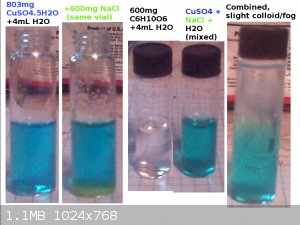 
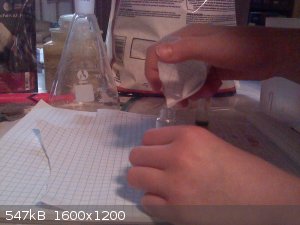
[Edited on 30-12-2017 by semiconductive]
|
|
|
semiconductive
Hazard to Others
  
Posts: 287
Registered: 12-2-2017
Location: Scappoose Oregon, USA.
Member Is Offline
Mood: Explorative
|
|
The vials have been sitting now for weeks. The first picture is how each of them looked just before I removed all the water except a drop from on
top. The second picture is after I removed the original aqueous solution from the yellow vial (ascorbic acid bath) and replaced it with water that
was saturated under butane gas to drive off as much oxygen as possible. As you can see, the surface started to turn green a few days after the
exchange in spite of the air being replaced by butane.
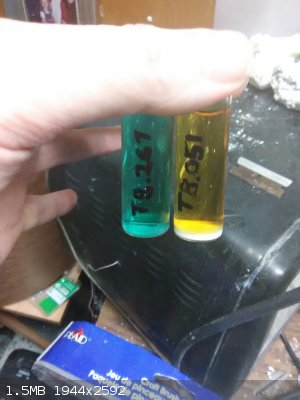 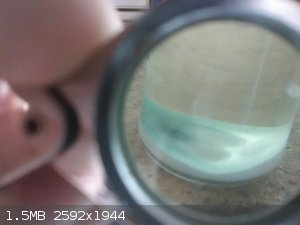
I plan on measuring the mass of the vials to get an amount of precipitate; but removing the water without oxidizing the precipitate is a problem. I'm
waiting for some special teflon tubing and gas exchange membranes so I can try drying precipitates under butane gas. There is no sign that the white
precipitate from the glucose solution is oxidizing to green. Its also not dissolving in water, so it's not glucose crystallized on the bottom. The
present state of the vials is shown below; On the left two is the glucose precipitate and solution, the right two are ascorbic acid precipitate and
remaining brown solution. I kept the solute before rinsing in the right vial of each pair. The color changes speak for themselves. The only source
of oxygen getting to the T8.051 vial is from the water ionizing to H+ -OH. The top 0.25mm or so is now green. There is no green color change in the
precipitate in the T8.267 vial.
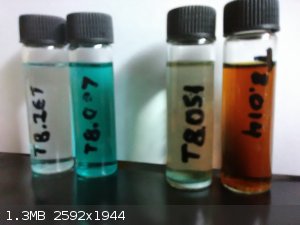
[Edited on 21-1-2018 by semiconductive]
|
|
|
Rhodanide
Hazard to Others
  
Posts: 348
Registered: 23-7-2015
Location: The 80s
Member Is Offline
Mood: That retro aesthetic
|
|
From my experience, reacting (but not neutralizing) Basic Cu Carbonate with 31.45% HCl, aggressively boiling the solution with copper metal for 15-20
minutes, and pouring the resulting green-black liquid in to cold distilled water produces a lot of Cu (I) chloride precipitate. Personally, I hate the
salt-reduction method. It's an unreliable method, and has never worked for me. The Copper-reduction method has worked beautifully for me five times
now, and I plan to do a sixth run. I have an entire pill bottle filled to the brim with CuCl, wet with Ethanol. Only the top has oxidized, everything
underneath is nice and pearly white!
[Edited on 22-1-2018 by Tetra]
|
|
|
DraconicAcid
International Hazard
    
Posts: 4278
Registered: 1-2-2013
Location: The tiniest college campus ever....
Member Is Offline
Mood: Semi-victorious.
|
|
Quote: Originally posted by semiconductive  | Quote: Originally posted by DraconicAcid  |
No. When an ionic compound like sodium chloride or sodium sulphate are dissolved in water, the ions become hydrated. The sodium ions hang around
with the water molecules, and have very little to do with the chloride ions unless the concentration is very high. I wasn't trying to point out that
sodium ions don't have brains- I always anthropomorphize ions and atoms because I'm usually explaining these things to kids. The sulphate ion in a
solution of sodium sulphate will act identically to a sulphate ion in a solution of ammonium sulphate, potassium sulphate, cesium sulphate, or even
aluminum sulphate- the ions wander far enough away that the sulphate has almost no interaction with the cation.
|
I've still been thinking about this carefully, and I still can't see how it can be true in a detailed sense.
All copper atoms act identically, as do copper ions. Therefore, if a copper ion separates from it's chloride in water (during "hydration" of copper+
chloride-) and thereafter doesn't interact ... then all copper atoms in the +2 oxidation state are colored purely by the copper ion's interaction with
water because the other ion is nowhere near. Therefore, all copper +2 ions should have EXACTLY the same color dispersion in water because it's the
water-copper interaction that determines the copper ion's hue.
Yet, the experiment I just did, and the Wikipedia article on Copper II prove the point that it has more than one color depending on which counter-ion
is closest to copper ions. ( Sulphate or Chloride, or even concentration of Chloride. ) |
Ions such as chloride or bromide will act as ligands to transition metals like copper; replacing water molecules as ligands will change the colour.
Dilute solutions of copper(II) chloride will be as blue as solutions of non-coordinating ions like sulphate or nitrate. As you increase the
concentration of chloride, you get greens and yellow. If you re-read the bit you quoted, you'll see that I was talking about compounds without
transition metals. Sodium, potassium, cesium, calcium will never be coordinated by chloride or sulphate at reasonable concentrations.
Please remember: "Filtrate" is not a verb.
Write up your lab reports the way your instructor wants them, not the way your ex-instructor wants them.
|
|
|
DraconicAcid
International Hazard
    
Posts: 4278
Registered: 1-2-2013
Location: The tiniest college campus ever....
Member Is Offline
Mood: Semi-victorious.
|
|
| Quote: |
The molecular formula I learned for basic copper carbonate is: HO-Cu-CO3-Cu-OH
The carbonate CO3, has one double bonded oxygen, and two single bonded oxygens.
Cu-OH
|
O
|
C=O
|
O
|
Cu-OH
|
But as I pointed out, it's an ionic compound, not a molecule. The anions may at best be coordinated to the copper, but they aren't forming
traditional covalent bonds.
| Quote: | | Three bonds puts oxygen in the -3 state .... !? |
No. The number of bonds, covalent or coordinate, does not determine the oxidation state.
| Quote: | | It's cool looking, but I have no idea what kind of bonds it's trying to depict. Oxygen doesn't make three single bonds. |
Ever hear of a hydronium ion?
| Quote: | | Hydrogen monoxide ? |
Hydroxide ion.
Please remember: "Filtrate" is not a verb.
Write up your lab reports the way your instructor wants them, not the way your ex-instructor wants them.
|
|
|
wg48
National Hazard
   
Posts: 821
Registered: 21-11-2015
Member Is Offline
Mood: No Mood
|
|
color of copper solutions
Here is a note that explains the color changes of copper ions.
Attachment: colcu bancroft1932.pdf (816kB)
This file has been downloaded 273 times
|
|
|
DraconicAcid
International Hazard
    
Posts: 4278
Registered: 1-2-2013
Location: The tiniest college campus ever....
Member Is Offline
Mood: Semi-victorious.
|
|
What's the date on that? 1933? 1938? Their theoretical explanations and musing about the colour of anhydrous copper(II) ions is almost painful to
read.
A copper(II) ion without any ligands will have no colour, because all the d orbitals will be degenerate. If you add ligands, they will stabilize some
d orbitals and destabilize others, causing an energy difference between them. If an electron goes from a low-energy d orbital to a high energy one,
it will absorb a photon of visible light, resulting in a colour.
The energy difference between the orbitals will depend on the kind of ligand (halide ion, water molecule, cyanide ion, amine) and the arrangement
(tetrahedral, octahedral, square planar, distorted octahedron).
Octahedral arrangements (or distorted octahedral) of copper with oxygen-based ligands are almost invariably blue (usually pale). Nitrogen donors such
as amines will usually form square planar or distorted octahedral with four amine ligands (sometimes two other ligands across from each other) which
tend to be deep blue or purple.
Anionic ligands such as halides will generally give tetrahedral complexes even when water is also coordinated to the metal (such as [CuCl3(H2O)]-).
These will often be green, or yellow (especially with chloride).
ETA: A better explanation = https://en.wikipedia.org/wiki/Crystal_field_theory
[Edited on 22-1-2018 by DraconicAcid]
Please remember: "Filtrate" is not a verb.
Write up your lab reports the way your instructor wants them, not the way your ex-instructor wants them.
|
|
|
semiconductive
Hazard to Others
  
Posts: 287
Registered: 12-2-2017
Location: Scappoose Oregon, USA.
Member Is Offline
Mood: Explorative
|
|
Quote: Originally posted by Tetra  | From my experience, reacting (but not neutralizing) Basic Cu Carbonate with 31.45% HCl, aggressively boiling the solution with copper metal for 15-20
minutes, and pouring the resulting green-black liquid in to cold distilled water produces a lot of Cu (I) chloride precipitate. Personally, I hate the
salt-reduction method. It's an unreliable method, and has never worked for me. The Copper-reduction method has worked beautifully for me five times
now, and I plan to do a sixth run. I have an entire pill bottle filled to the brim with CuCl, wet with Ethanol. Only the top has oxidized, everything
underneath is nice and pearly white!
[Edited on 22-1-2018 by Tetra] |
Thanks. 
You're basically repeating Draconic Acid's suggestion on the first page. I intend to try that method also, as it's a worthy technique. However; The
salt method did work for me, so I don't think it's unreliable so much as very sensitive to stoichiometry. I'm learning a lot by messing with the
salts, but can understand why salt would fail for lots of people with limited equipment.
|
|
|
semiconductive
Hazard to Others
  
Posts: 287
Registered: 12-2-2017
Location: Scappoose Oregon, USA.
Member Is Offline
Mood: Explorative
|
|
Quote: Originally posted by DraconicAcid  |
Ions such as chloride or bromide will act as ligands to transition metals like copper; replacing water molecules as ligands will change the colour.
... If you re-read the bit you quoted, you'll see that I was talking about compounds without transition metals. Sodium, potassium, cesium, calcium
will never be coordinated by chloride or sulphate at reasonable concentrations. |
I'm a newbie; I would never have made the connection between the type of ions and replacing of water molecules based on the type of ion on my own.
My background is, again, semiconductor physics in the solid (crystalline) state. I only have 100 and 200 level chemestry courses in my background,
and no o-chem. Your clarification is very much appreciated. I'm beginning to understand a few other things you said, now.
Transition metals are special because of D orbitals, so there are up to 10 electrons to fill the D shell. Copper is the 9th electron in the period,
so it is only one electron shy of a full shell. Zinc, the next metal, would be questionable as a transition metal because it's shell is full an
unreactive.
Still, the problem with the qualitative ideas you are giving me is that I have no experience to decide when something is "normal" or "high"
concentration. Just as I can't know how far apart ions will stay (on average) in a liquid -- regardless of whether they are transition metals or not.
Take for example, hydrogen. It's in the first two columns of the periodic table ... so that means 1S and 2S orbitals are on the outside. According
to what you have said, it's not something that would be coordinated by sulfate or Chloride; for it's in the same S orbital columns of the periodic
table as sodium and calcium. However, sodium chloride is clear at very high concntrations (even saturation); but Hydrogen Chloride is greenish in
test tube solution. So, Sodium vs. Hydrogen changes the color of the solution. But, hydrogen is part of water ... and there are [H+] [OH-] ions
floating around in water ... so again, if Na was not close to Cl ... then the hydrogen in water should make NaCl solution green ... but it's clear.
There are often exceptions to the things you have been stating in an almost absolute sense. It's hard for me to track without quantitative ways to
calculate outcomes why the things you say are true, and in what sense. You have a lot of experience and easily recall exceptions, but I don't. That
weakness of mine is obviously a big part of my troubles. I don't have a way to get a "feel" for what is normal and concentrated... what is "close"
together in a solution, and what is far apart ... etc. To me, they are all atoms with often invisible and complicated interactions going on in
solution. It's extremely difficult for me to reason to a conclusion in such a situation. I do appreciate your patience.
|
|
|
DraconicAcid
International Hazard
    
Posts: 4278
Registered: 1-2-2013
Location: The tiniest college campus ever....
Member Is Offline
Mood: Semi-victorious.
|
|
| Quote: | I'm a newbie; I would never have made the connection between the type of ions and replacing of water molecules based on the type of ion on my own.
My background is, again, semiconductor physics in the solid (crystalline) state. I only have 100 and 200 level chemistry courses in my background,
and no o-chem. Your clarification is very much appreciated. I'm beginning to understand a few other things you said, now.
Transition metals are special because of D orbitals, so there are up to 10 electrons to fill the D shell. Copper is the 9th electron in the period,
so it is only one electron shy of a full shell. Zinc, the next metal, would be questionable as a transition metal because it's shell is full an
unreactive. |
Yes, zinc is often not considered to be a transition metal, and because it always has full d orbitals, its compounds are never coloured unless a) the
anion is coloured (such as zinc permanganate) or b) the ion is very easily reduced (which gives colour due to charge transfer- this would be the case
for lead(II) iodide, but I can't think of an example for zinc).
| Quote: | | Still, the problem with the qualitative ideas you are giving me is that I have no experience to decide when something is "normal" or "high"
concentration. |
That depends on the ions in question. Cyanide is an excellent ligand, and will coordinate even at low concentrations. Chloride may coordinate to
copper at *waves hands* say, 1 mol/L, but it won't coordinate to nickel or manganese unless at a much higher concentration. Choride won't coordinate
appreciably to iron(II), but will coordinate readily to iron(III). Nitrate, perchlorate and sulphate won't coordinate unless the solution is so
concentrated that it no longer really qualifies as an aqueous solution.
| Quote: | | Just as I can't know how far apart ions will stay (on average) in a liquid -- regardless of whether they are transition metals or not.
|
On average, the tendency for a metal ion to be coordinated by, or at least pair up with an anion is determined by the radius of its charge to its
radius. A small and/or highly charged ion will be coordinated much more readily than a large one with a low charge. This is why the alkali metals
don't do coordination chemistry.
| Quote: | | Take for example, hydrogen. It's in the first two columns of the periodic table ... so that means 1S and 2S orbitals are on the outside. According
to what you have said, it's not something that would be coordinated by sulfate or Chloride; for it's in the same S orbital columns of the periodic
table as sodium and calcium. However, sodium chloride is clear at very high concntrations (even saturation); but Hydrogen Chloride is greenish in
test tube solution. So, Sodium vs. Hydrogen changes the color of the solution. But, hydrogen is part of water ... and there are [H+] [OH-] ions
floating around in water ... so again, if Na was not close to Cl ... then the hydrogen in water should make NaCl solution green ... but it's clear.
|
Hydrogen isn't an alkali metal, though- it's a non-metal, despite being in the same column as sodium. The H+ cation doesn't have *any* filled
orbitals, so it would be orders of magnitude smaller than any ion. Thus, it *always* forms a covalent bond with something- an anion, or a water
molecule (to make the hydronium ion H3O+). That's why hydrogen chloride is a molecular gas at room temperature, and sodium chloride is an ionic
solid. If HCl is greenish, it would be due to electrons moving around in molecular orbitals, not the d orbitals responsible for transition metal
compounds.
| Quote: | | There are often exceptions to the things you have been stating in an almost absolute sense. |
I'm trying to keep things simple.
| Quote: | | I do appreciate your patience. |
I'm glad I still seem patient- my students think I've been snarling at them lately. But I hope my comments have been helpful.
Please remember: "Filtrate" is not a verb.
Write up your lab reports the way your instructor wants them, not the way your ex-instructor wants them.
|
|
|
semiconductive
Hazard to Others
  
Posts: 287
Registered: 12-2-2017
Location: Scappoose Oregon, USA.
Member Is Offline
Mood: Explorative
|
|
I came across a youtube video, where a person put a jacob's ladder with copper electrodes inside a fish bowl with a sealed lid. The strength of the
acid was surprising after an overnight.
All it needs is an old broken microwave's transformer.
https://ru-clip.com/video/ep23ds4cZs4/nitric-acid-from-thin-...
|
|
|
semiconductive
Hazard to Others
  
Posts: 287
Registered: 12-2-2017
Location: Scappoose Oregon, USA.
Member Is Offline
Mood: Explorative
|
|
Thanks. That's very helpful in an Amateur's ability level. There were several anecdotes that were useful in me forming a stronger opinion about
what's really going on, intuitively.
I had to laugh though, page 1064: "7. Copper Oxide is blue and not black"
That's quite possible as dark blue and black are hard to distinguish by eye.
I know from expeience that copper I oxide looks reddish, and copper II oxide looks black to the naked eye.
But even the author, after realizing that the (II) oxide ought to be blue, said a few pages later: 1068: This is apparently due to to formation of
undissolved, black, cupric oxide.
So there are some points which are ambiguous because of human sight.
I've purchased a 1000 line/mm diffraction grating and have been planning to build a spectrometer capable of visible and infrared measurements down to
10 micron. Unfortunately, plastic of diffraction gratings are not good to infrared wavelengths used in transmission mode; and to get it to work in
reflection mode, I need to silver the back side of the film. I tried talking with the local high school chem teacher who has his students build a
crude spectrometer for visible wavelengths using an LED, and although he's excited about the idea of a wide range spectrometer for low cost, he
doesn't have the time to help me (wife needs attention kind of problems...!). So, it won't be until one of my sons is in his Chemistry class next
year that I have an excuse to pursue an advanced spectrometer with him. But that's what is really needed to fine tune the experients being conducted
on color. Thermal agitation ought to change the colors of the ions slightly, not enough to be seen by the human eye or a simple camera, but something
that could be measured by a simple spectrometer. That would be an invaluble tool in figuring out what is really going on in aqueous chemistry.
Again, I appreciate the link. I learned a lot. 
It's fairly obvious that the solute changes affected the color based only on molecules that were in intimate contact or proximity to the copper. Not
more than one molecules distance away. That means color is affected more by the number of water molecules, vs. counter IONS displacing water
molecules than even electric fields from nearby ions. eg: the color of copper is affected more by molecules DISplacing water, than by their
interaction with the copper itself.
The author's distinction between opacity (clarity), and color, is not always clearly stated; but that's one of the major reasoning tools to figuring
out what is really going on. The shade of color vs. intensity, allows one to crudely distingusih between degree of ionization, and type/cause of
ionization/coordination.
Cuprous ions obviously have the energy potential for producing the red-yellow range, while Cupric ions have energy levels compatible with the
green-blue range of colors.
Browns and blacks, being combinations of colors, need to be identified with a spectrometer and not the human eye for an accurate assesment of the
combinations of greens, blues and reds which are treuly present..
[Edited on 24-1-2018 by semiconductive]
|
|
|
DraconicAcid
International Hazard
    
Posts: 4278
Registered: 1-2-2013
Location: The tiniest college campus ever....
Member Is Offline
Mood: Semi-victorious.
|
|
Quote: Originally posted by semiconductive  |
Thanks. That's very helpful in an Amateur's ability level. There were several anecdotes that were useful in me forming a stronger opinion about
what's really going on, intuitively.
I had to laugh though, page 1064: "7. Copper Oxide is blue and not black"
That's quite possible as dark blue and black are hard to distinguish by eye. |
The article is good at being descriptive, but suffers from being written prior to the development of crystal field theory. The colour of the
copper(II) ion is not determined by the number of water molecules present, but the number and kind of ligands attached to the copper, of which water
is only one kind.
Please remember: "Filtrate" is not a verb.
Write up your lab reports the way your instructor wants them, not the way your ex-instructor wants them.
|
|
|
Σldritch
Hazard to Others
  
Posts: 309
Registered: 22-3-2016
Member Is Offline
Mood: No Mood
|
|
Reducing sugars are reducing because they can become aldehydes in solution. Ascorbic acid is oxidised to form a radical. Why one seems to reduce
Copper (II) to Copper (I) Chloride in these conditions i do not know. At least it is a clue.
|
|
|
semiconductive
Hazard to Others
  
Posts: 287
Registered: 12-2-2017
Location: Scappoose Oregon, USA.
Member Is Offline
Mood: Explorative
|
|
Quote: Originally posted by DraconicAcid  | | Quote: |
That depends on the ions in question. Cyanide is an excellent ligand, and will coordinate even at low concentrations. Chloride may coordinate to
copper at *waves hands* say, 1 mol/L, but it won't coordinate to nickel or manganese unless at a much higher concentration. Choride won't coordinate
appreciably to iron(II), but will coordinate readily to iron(III). Nitrate, perchlorate and sulphate won't coordinate unless the solution is so
concentrated that it no longer really qualifies as an aqueous solution.
|
[/rquote]
Beautiful; and you're proving my point about the deep nature of your experience and empirical knowledge which a newbie lacks.
| Quote: |
| Quote: | | Just as I can't know how far apart ions will stay (on average) in a liquid -- regardless of whether they are transition metals or not.
|
On average, the tendency for a metal ion to be coordinated by, or at least pair up with an anion is determined by the radius of its charge to its
radius. A small and/or highly charged ion will be coordinated much more readily than a large one with a low charge. This is why the alkali metals
don't do coordination chemistry.
|
I see, and that is the most useful thing you have told me so far in this thread. 
Thank you!
| Quote: |
Hydrogen isn't an alkali metal, though- it's a non-metal, despite being in the same column as sodium.
|
Yes, but think about that for a moment. Metals are classified as metals from their physical properties when crystallized; eg: conductivity, and
related reflectivity (shiny!). For it's the conductivity, when maxwells equations are solved that has a lot to do with succesfully making a mirror.
There are different ways to get conductivity, but the idea of metal .. is one where in the crystal state the molecular orbitals overlap and are only
partially filled. That means the topmost electrons are free to travel because they can "jump" to nearby energy states that are vacant. In contrast,
non conductors have a filled valence band ... but there are no empty states nearby for electrons to "jump" to. It takes significant energy, on the
order of a photon of visible light, to promote electrons in a non conductor.
No metal is really acting like a "metal" when ionized in water solution. The bands surrounding the ions are at most molecularly coupled to a handful
of very nearby water molecules. So, the important distinction has notihing really to do with being a metal and a "conduction" band ... The important
distinction is how a particular atom molecularly hybridizes it's orbitals with water or other solvents, and why.
| Quote: |
The H+ cation doesn't have *any* filled orbitals, so it would be orders of magnitude smaller than any ion. ... If HCl is greenish, it would be due
to electrons moving around in molecular orbitals, not the d orbitals responsible for transition metal compounds.
|
Of course. I agree, that's why I pointed out 1S and 2S orbitals as being the outer unfilled orbitals involved in bonding. It's just that those are
the same shaped orbitals as the other alkalai metals, and ought to behave similarly. In the case of hydrogen, then, as an exception it DOES matter
that the chloride atom is floating nearby or at very least displacing water from contact with the hydrogen to change the color. The exact color will
depend on the quantum states which are stable in whatever solvent the hydrogen is in and the counter-ion which is near it (if any).
| Quote: |
I'm glad I still seem patient- my students think I've been snarling at them lately. But I hope my comments have been helpful.
|
You might try starting your sentences with a different word than "no." Whether you are correcting a small mistake or a big one, the word "no" can
make a student feel like a dog or baby in a family. Once the adrenaline rushes, their ability to reason is often diminished. I realize there are
some bone headed students that you have to get their attention before they will even listed ... ADHD people ... but for your brighter students, you
might try using a less absolute opener to your corrections; eg: "not quite", or "have you thought of..."
Your comments are a very steep learning curve. In the past, I would say they have not been extremely helpful ... but that's not to say they won't
prove more useful in the future. For me, I still haven't seen copper oxide dissolve in ammonia water. I have ONLY seen it dissolve in ammonia water
exposed to air and expecially carbon dioxide. So, it's not that you are necessarily wrong ... but you've given me a contradiction to my experience
that I need to test and quantify. If something dissolves only a handful of atoms out of a gram ... that might be what you mean; but I have no way to
grasp these things without testing them.
I'm also fighting several sources of error. My scale, for example, has a hysterisses effect. I've been testing boyancy issues, water absorbtion of
air, and other reasons for my scale giving nonstandard results. BUt, after the past few days I realized that the mechanism inside is a strain guage
on a metallic bar; that guage deflects more or less depending on it's immediate past history and possibly even magnetic state. The software is pretty
good at hiding it ... but it's still giving me errors of up to 4 milligrams. So, the experiments I did in this thread need to be redone once I've
figured out ways to degauss the strain guage during operation and weighing of mass.
It's all the little things that keep biting me in the ass, that are making it difficult to isolate individual issues as is required in the scientific
method to "test one thing at a time" while keeping all others constant. It's not your comments, so much as the time it takes to isolate the issues.
[Edited on 25-1-2018 by semiconductive] |
|
|
|
semiconductive
Hazard to Others
  
Posts: 287
Registered: 12-2-2017
Location: Scappoose Oregon, USA.
Member Is Offline
Mood: Explorative
|
|
DraconicAcid, how's your quantum mechanics?
That article gets into the nitty gritty and I've been studying these issues of magnetic spin coupling and non-degeneracy for semiconductors for over
six months now.
For example, here's a thread I opened on electronic's stack exchange:
https://electronics.stackexchange.com/questions/309097/semic...
The graph tells a lot; for I'm comparing experiment to theory and you can see the graphs don't quite match. I've spent six months buying master's
thesis, asking questions on physics forums, etc. and basically; nobody knows how to solve these issues. The issue is spin-orbit coupling, and landau
level effects.
Bascially, the author's of the original article I tried to reproduce used a wrong equation to compute the effective mass of electrons. ( Which even
in molecular orbitals can be used to test them for the ability to make certain colors. )
Your crystal theory link makes an interesting assumption that is directly related to band theory (molecular orbitals when statistically many atoms are
nearby) and the magnetic fields. Unfortunately it will be wrong in many cases; but if the crystal theory is right, then semiconductor band theory
MUST be wrong in a large number of cases.
I have been asking people about the details of QM in magnetic fields... but the online physics forums are basically worthless. I end up solving
everything myself with no guidance ... and it's taken months to realize and prove where the problem lies. I have experimental evidence to back up my
conclusions ... but seeing the crystal theory paper makes me groan because there's another subtle issue in it.
https://www.physicsforums.com/threads/cyclotron-resonance-an...
Do you have the background and time to dig into the reasons why the Aufbau principle is clearly being violated in the "high spin" drawing of the link
you gave? The author only mentions that the "Hunds rule" is not followed (There are more than one rule called, Hunds...)
There is clearly a spin, or angular momentum, and orbital interaction issue similar to zeeman splitting and landau levels in band theory at the heart
of crystal theory.
State of the art semiconductor physics as taught in colleges at the masters level, is wrong in many cases because they ignore how much the magnetic
fields of cyclotron measurements affect the energy of electrons. That's why I linked stack exchance, was to show how far off the standard master's
levels analysis of semiconductors is.
The reason is that the analysis is usually semi-classical.
In classical physics, magnetic fields can only change the direction but not energy of an electron. However, in QUANTUM physics the Heisenburg
uncertainty basically requires that even a magnetic field MUST affect the energy of an electron in an orbit.
Eariler, I ingored your offer to work out mass action law in terms of thermodynamics; becasue the first page of my thermodynamics book says "The laws
of thermodynamics are empirical laws..." ... so there's no point in doing that to prove mass action which my teacher said was "an empirical law".
But if you are able to work QM problems with me, that would be very helpful in understanding crystal theory !
[Edited on 25-1-2018 by semiconductive]
|
|
|
DraconicAcid
International Hazard
    
Posts: 4278
Registered: 1-2-2013
Location: The tiniest college campus ever....
Member Is Offline
Mood: Semi-victorious.
|
|
| Quote: |
Yes, but think about that for a moment. Metals are classified as metals from their physical properties when crystallized; eg: conductivity, and
related reflectivity (shiny!).
No metal is really acting like a "metal" when ionized in water solution. The bands surrounding the ions are at most molecularly coupled to a handful
of very nearby water molecules. So, the important distinction has notihing really to do with being a metal and a "conduction" band ... The important
distinction is how a particular atom molecularly hybridizes it's orbitals with water or other solvents, and why. |
That may be the physicist's definition of a metal, but a chemist defines a metal as an element that tends to lose electrons to form cations when it
reacts with a nonmetal. Hydrogen, unlike sodium, lithium, etc, does not form simple cations, and always forms either molecular compounds, or becomes
part of a covalently bonded polyatomic cation. So sodium, lithium, potassium etc. all act like typical metal ions in solution, whereas hydrogen shows
very different behavior.
| Quote: | | Of course. I agree, that's why I pointed out 1S and 2S orbitals as being the outer unfilled orbitals involved in bonding. It's just that those are
the same shaped orbitals as the other alkalai metals, and ought to behave similarly. |
In the case of hydrogen, it uses its 1s orbital for bonding. For the alkali metals, apart from very rare compounds such as methyllithium, their
bonding is almost purely ionic, and they don't use orbitals for that- just cation attracting anion.
[Edited on 25-1-2018 by DraconicAcid]
Please remember: "Filtrate" is not a verb.
Write up your lab reports the way your instructor wants them, not the way your ex-instructor wants them.
|
|
|
semiconductive
Hazard to Others
  
Posts: 287
Registered: 12-2-2017
Location: Scappoose Oregon, USA.
Member Is Offline
Mood: Explorative
|
|
Quote: Originally posted by DraconicAcid  |
The article is good at being descriptive, but suffers from being written prior to the development of crystal field theory. The colour of the
copper(II) ion is not determined by the number of water molecules present, but the number and kind of ligands attached to the copper, of which water
is only one kind. |
My copper sugar experiments are only in water; so that's the part of the article I was focusing on; eg: that which applies to the case at hand.
To be fair to the author, he did not make a mistake that was reducing the issue to water alone. Neither did I intend to imply that only water was
involved in color making. The paper clearly states that the hue of "blue" changes when ammonia is the solvent instead of water. Therefore, even this
ancient author gives an example proving they knew that color depends on kind of ligands and well as number.
|
|
|
| Pages:
1
2
3 |
|